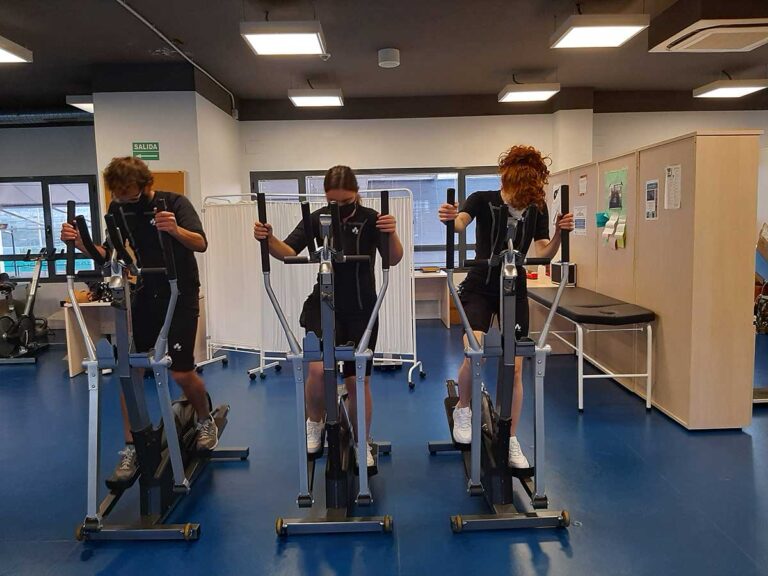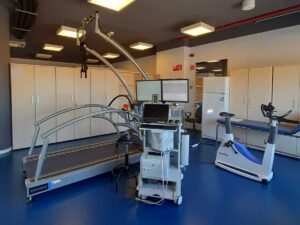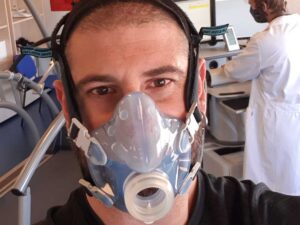Heart rate (heart rate) is an exercise monitoring variable that tells us the heart rate. Normally, the higher the intensity, the higher the heart rate and, therefore, more fatigue and a greater impact on performance and health.
That is why the whole body global electrostimulation (WB-EMS) is a tool that serves to raise the heart rate, in addition to having other benefits.
In previous entries such as “How much heart rate can vary in training with EMS” and “Relation of electrostimulation and electrical and heart rate in energy expenditure” we have already seen the methodology carried out during this cross-sectional study and part of the heart rate results by individual.
It should be noted that there are multiple possibilities for analysis with this data, and that is why, from the Wiems Lab, we have decided to continue analyzing this evaluation of heart rate, focusing on the changes that occur in the two frequencies.
Although we have mentioned it in previous blog posts, it is important that we understand that the selected frequencies are part of the overall program count offered by the Wiemspro training application.
Our objective is to investigate which are the best EMS methodologies to achieve different objectives, but above all we want to investigate the benefits of electrostimulation, and offer the trainer and fitness professionals tools to improve their training.
In the Wiemspro training app we have programs for:
- 7 Hz as “Warm-up 1” and “Continuous Cardio 1” in green color (color used for people just starting EMS, and for slow twitch recruitment).
- Likewise, we have “Heating 3”, “Classic 1” or “Circuit adaptation 1”, which use 21 Hz.
Since these frequencies are commonly used within Wiemspro equipment, we decided to see what happens when we apply EMS to a low intensity elliptical exercise.
The objective of this study is to analyze how the drift in heart rate was when performing the exercise at low intensity, but differentiating what happened with each participant at each frequency.
Assessment
As in previous studies, in this one we once again have a heart rate monitoring sensor such as the Polar OH1, which is placed on the forearm; in this way, electrical impulses do not interfere with data collection.
After extracting and processing the data, we developed a formula to obtain the following graph:

Here we can see the total testing time with heart rate increases throughout.
On this occasion, we show the data of a participant who performed a very good test. This participant was used to exercise, so during the test his intensity level was higher than the rest. We can see that this person had a higher heart rate in the second rate (from minute 41) although the trend was completely the opposite.
We can observe that there are three different moments within the curve:
- Calculation of the intensity of the elliptical.
- 20 minutes of exercise (5 cardio and 15 EMS) with the 1st frequency.
- 20 minutes of exercise (5 cardio and 15 EMS) with the 2nd frequency.
Next, we are going to analyze what happened with several participants in the two frequencies, but first we suggest reading the previous blog entry where we explained the previously commented graph in detail.
Analysis by frequencies
The frequency analysis is a graphical representation of the participants with whom we first apply 7 Hz and then 21 Hz and vice versa. The analysis will allow us to observe some distortion in the increase in heart rate when we first set one frequency, or when we set others. This is due to the following: if we always work with 7 Hz as the first frequency, what happens with 21 Hz will be influenced by what has happened with the previous frequency. However, if we manage to get some participants to work first at 7 Hz and other participants at 21 Hz, the results will not have anything to do with the order of application.
7 HZ
First, let’s see what happened to the heart rate response at 7 Hz in order of application:

As we can see in the image, we can confirm that the evaluation protocol was carried out systematically and following the same steps with all the participants.
We see that everyone starts with their part of cardio, and that the application of the WB-EMS goes according to the stipulated (5/10, 7/10 and 8/10). In addition, it is important to emphasize that the response in each of the participants was a little different:
- Thus, the second graph in the first row and the third graph in the second row show fairly flat elevation relative to their peers.
- But on the other hand, the heart rate in the third graph of the first row rises considerably after the application of WB-EMS
This difference with the others can manifest a non-response on the part of certain participants, which makes us wonder: Are there responders and non-responders to EMS?
We can also highlight that all the participants reached a heart rate between 91-93% of the maximum heart rate, at an intensity of 8/10 with EMS.
21 HZ
We have also analyzed the heart rate response at 21 Hz in both orders of application:

Unlike the previous frequency, this time we see that the participants compared themselves in a very different way. They all follow the same trend, although some more pronouncedly, and others with a little less inclination. These data reinforce the idea that some participants have a greater response to EMS, while in other people there is no such response.
Likewise, it is important to note that when working at 21 Hz as the first frequency, the cardio heart rate is at values slightly above those we had stipulated, however, when they are placed in second place, the cardio heart rate is extremely high.
This helps us understand that if we want to maintain a light-moderate intensity, and we don’t want the heart rate to rise too much because there is a greater risk, or because that is not the training zone where we want to improve, it will be important to have a careful control of electric charge and external charge.
What we are clear about is that the heart rate response at 21 Hz is less than at 7 Hz.
Results
These results can be useful for trainers who are starting to train with EMS, and do not have enough experience yet to know what impact WB-EMS has on the body.
From now on, when working with EMS, we will know what the responses offered to the increase in electrical frequency, or the increase in intensity from 5/10 to 8/10 may be. From the results obtained, we would also like to focus on the effect that EMS has when it is placed at a low intensity, such as 5/10 on the comfort scale.
In view of the results obtained, we can verify that, in general, this intensity is capable of raising the heart rate by ~10 bpm. This can be interesting, not only for the benefit of the increase in heart rate itself, but also because EMS is a very motivating tool for the trainer.
We can verify from the testimonials of our participants that EMS is liked, and that the training sensation is different.
On this occasion, we have carried out continuous aerobic training that is often tedious for some people, however, with EMS the training becomes more dynamic, and also provides greater benefits at the cardiovascular level and muscle tone.
In future studies we will first assess whether EMS has an acute effect on muscle; and second, if so, how much or to what extent the EMS affects.
Conclusion
Thanks to the analysis carried out with the different electrical frequencies, we have been able to observe the difference when a frequency is applied in the first place vs. when it is applied in the second place. Also, these two frequencies have a direct effect on slow twitch fibers, and we have been able to elucidate what happens to the heart rate when these two widely used frequencies are applied at the beginning of any EMS program. We will highlight 3 conclusions:
- The participants respond differently to the same stimulus due to their own condition or because they are not able to correctly establish the degree of comfort 5/10, 7/10 and 8/10.
- The order of application of EMS is important, and its application will depend on our objectives.
- Heart rate responds differently at 7 Hz and 21 Hz.
Likewise, from Wiems Lab we will continue to investigate the increases in heart rate that can be caused by other frequencies and in a different order of application.
Unai Adrian Perez de Arrilucea
Wiems Lab Team







